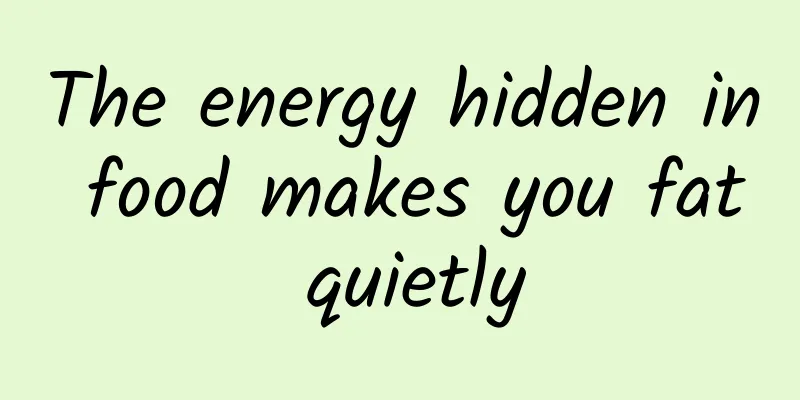The energy hidden in food makes you fat quietly

|
If you want to lose weight effectively and avoid rebound, a key point is to ensure a slight negative balance of daily energy intake, that is, energy consumption should be slightly higher than energy intake. In simple terms, it means eating less and moving more. For this reason, many beauty-conscious women make a vow: "In the next N months, I will diet and lose weight!" Unfortunately, many people say after only a few days: "It's too painful to not be able to eat anything!" "Forget it." Weight loss is actually a science. Only by eating and exercising scientifically can you lose weight healthily and maintain a healthy weight. For most people who want to lose weight, we recommend that you control your energy intake and increase your protein and dietary fiber intake. However, there are too many food temptations in our daily lives - snacks, desserts, barbecue, cold drinks... Are these not allowed? Do we need to avoid them? The truth is not that cruel! Here we will teach you how to discover the high-energy-density foods around you, so that you can eat scientifically and lose weight scientifically. What foods should not be eaten too much Energy density refers to the amount of energy contained in every 100 grams of food, in kilojoules or kilocalories. For example, if you see a certain brand of biscuits with "100 grams contains 200 kilocalories" in the nutrition facts table, that is the energy density. In daily life, if the energy contained in every 25 grams of non-liquid food or every 100 milliliters of liquid food is greater than 100 kilocalories, then you should be careful about the risk of excessive energy intake. Which foods are risky? Remember two rules: First, for the same food, the more water it contains, the lower its energy density, such as fresh fruits, vegetables and fresh meat; the less water it contains, the higher its energy density, such as dried fruit and beef jerky. Second, for different foods, the less water content and the higher the fat and carbohydrate content, the higher the energy density , such as fried chicken legs, potato chips, and French fries. In addition, many processed foods contain refined sugar, which can also increase energy, such as cola, Sprite, candied fruit, etc. Foods that have both refined sugar and oil added will have a higher energy density, such as cakes, donuts, peach cakes, etc. How do we find high energy density foods when we choose and buy them? The first thing is to learn to read the nutrition label of the food. Look at the food ingredient list: foods that have added fats such as non-dairy creamer, vegetable oil, cooking oil, and sugars such as white sugar and fructose tend to contain high energy. Look at the nutritional information table: First, look at how much energy is contained in 100 grams of food. According to the previous article, if the energy per 100 grams of non-liquid food exceeds 1672 kJ (400 kcal) or the energy per 100 ml of liquid food exceeds 418 kJ (100 kcal), please be careful to consume in small amounts. In view of the principle of "increasing protein, reducing fat and carbohydrates" when losing weight, it is necessary for everyone to pay attention to the "NRV%" (nutrient reference value percentage) on the far right of the nutritional table. If the NRV of energy, carbon water and fat is higher than the NRV of protein, it means that the protein content of the food is lower and it is possible to consume more energy. How to choose ingredients wisely When cooking and buying groceries, please learn to choose ingredients that are less likely to make you fat. 1. Buy fresh vegetables: leafy vegetables, melons and vegetables, mushrooms, and kelp are all good choices for weight loss; be cautious with starchy vegetables, such as potatoes, lotus roots, and yam. 2. Eat limited amounts of fruit: All fruits contain sugar, and eating too much will make you fat. Eat a fist-sized piece of fruit a day. Try to stay away from tropical fruits that have low water content. 3. Eat whole grains: The main component of refined grains such as white rice and white flour is starch (carbohydrate). Eating more will make you fat, and eating less will make you hungry. Whole grains and miscellaneous grains are rich in dietary fiber and have a lower energy density than refined rice and flour. 4. Choose lean meat from poultry and livestock: For poultry and livestock, try to choose lean meat with less fat content, such as chicken breast, chicken legs, tenderloin, and tendon. Do not eat the skin and subcutaneous fat. After cutting, blanch the meat in water to filter out some fat and purine. Do not drink broth during weight loss. (Source: Beijing Science and Technology News) |
<<: Popular Science Illustrations | Understanding the "Kidney of the Earth" - Wetlands
>>: Why do plant leaves change color?
Recommend
Why do Samsung Tizen phones always get delayed?
Samsung announced last Friday that the Tizen smart...
The Long March 5B rocket is being transported, and the Mengtian experimental module will be launched soon
On October 25, the Mengtian experimental module a...
TrendForce: Global Power Battery Recycling Market to Exceed 1 Trillion Watt-hours in 2030
TrendForce predicts that the rapid growth of glob...
Xiamen’s latest settlement policy in 2022: Will Xiamen cancel restrictions on settlement?
The People's Government of Xiamen City issued...
Why doesn't Samsung S7 use USB Type-C?
As we all know, USB Type-C will replace the exist...
What modern academic qualifications do the ancient scholars, juren and jinshi correspond to?
The ancient imperial examination system was the f...
Is lying harmful? Be an honest Pinocchio!
I believe everyone has heard of the fairy tale of...
A Tesla Model 3 consumes $1,500 worth of semiconductors. Chips may become the weak spot of China's auto industry
UBS’s recent fourth and fifth reports are very in...
As catastrophic tipping points approach, how should humanity respond?
The vicious cycle of catastrophic climate change ...
Sony was fined 1 million yuan. These advertising laws should be remembered.
Do you still remember that Sony was unanimously b...
It is not easy for e-commerce to enter rural areas. Three major obstacles need to be addressed.
Almost all e-commerce companies are considering o...
Analysis of Douyin short video competitors!
Analysis of Douyin short video competitors 1. Bac...
One-click skinning
Source code introduction Screenshot of source cod...
Opportunities and growth space for vertical media advertising monetization in 2020
In the mobile Internet era dominated by giants, s...









